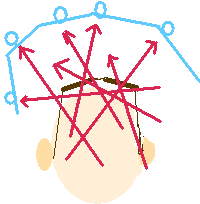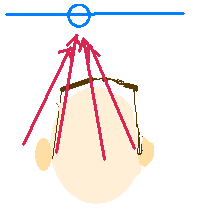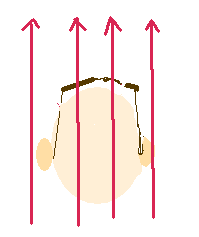

4351. Prep Trap
Example 1: 'p.t.'
'Coming to p.t.' (Present Time) is an example of a pattern of intentional contracting ('concentration') with the purpose of bringing order into something. Typically, the person's perception then fails to expand again.
To begin with, the attention units of an 'ordinary' human being are scattered all over a projected timeline, making the Being seemingly 'stuck in the past':

As a remedy, the person could ignore stuck
attentions by concentrating on a time slice that it projects as 'Present
Time' or undo stuck attentions except those in p.t.:

This, however, is a preparatory step and not the final objective.
So far, it is tunnel-vision. If expansion does not occur after the initial contraction, the Being becomes 'concentrated' (literally!!) and is figuratively 'smaller' than before.
In other words, if a 'concentration' exercise or practice is not immediately followed by un-focussing again (cp. 'Focus') or if it is not followed by permeating a medium or the Universe as such, it can quickly become a 'prep trap' (cp. 'Introversion, Extroversion, and Permeation').
At least, a Being must be able to view time in a larger perspective. But optimally the person runs something like Filbert's 'Trackblaster' process or follows something along the line of Dennis Stephens ('TROM/'time breaking'). Then there is no limit to a Being's perception of time anymore because the illusion of a timetrack has been broken apart (hopefully in a smooth way):

Limiting the attention of people regarding
'time' is a favorite tool of cult masters. Especially in conjunction with
the 'on-the-roll' trap, one can quickly raise
robots who will execute the orders of their masters without questioning
or even a second-thought about it.
An interesting situation occurs when a person really tries to limit their attention on a single point of time. This then becomes an exercise, let's call it the 'catch-the-moment' process. It is best done with a noisy clock and by first limiting one's perception of time to strictly the time in between beats. This will induce a feeling of 'shifting' through time.
Once this feeling is there, one can try to 'hold' this feeling while shifting through the intervals of one second each. This can result in 'time' virtually falling away left and right. Surprisingly (or not?), arresting time will create a very similar perception as 'boundless time'. The perceptions of 'No time at all' and 'all the time' are practically not distinguishable. Even before this point, however, a person will be unable to perform any coordinated tasks, as simple as they may appear to be.
'Being in Present Time', therefore, in praxis
means 'being limited to a strictly limited time slice', which is a feature
that animals share with robots.